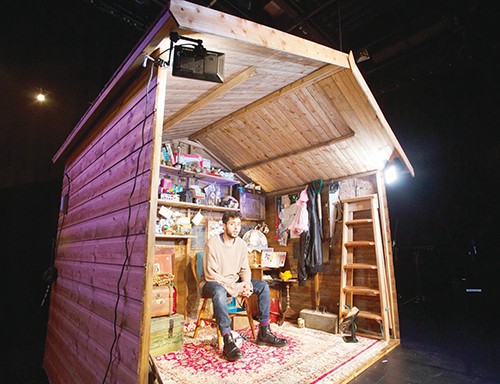27/08/2020
27/08/2020
Global creative hub laid low with virus

EDINBURGH, Scotland, Aug 27, (AP): Francesca Moody is spending August the way she always does: in darkened rooms in Edinburgh, watching some of the best new theater and comedy the world has to offer.
All that’s missing are the hundreds of thousands of other people who usually do the same in Scotland’s capital.
“It’s strange to be in a city that you’re so used to being saturated with culture and arts and people,” Moody, a theater producer, said backstage at the city’s shuttered Traverse Theatre.
Usually the venue is a hub for performances at the Edinburgh Fringe, the vast performance festival that helps turn the city into a global creative hub every summer — drawing crowds, generating buzz and filling the coffers of hoteliers, pub-owners, shopkeepers and tour guides.
Every summer except this one. The Fringe, the high-toned Edinburgh International Festival, the Edinburgh International Book Festival, the Art Festival and the city’s bagpipe-swirling Military Tattoo were all casualties of the UK’s coronavirus lockdown. Their cancellation was a body blow to Britain’s thriving creative economy, and to Edinburgh’s booming tourism sector.
But there are glimmers of light in artists’ and organizers’ determination that the festivals will return — even if it’s in a smaller, more digital form.
Moody knows all about the power of the Fringe. At the 2013 festival she produced “Fleabag,” a one-woman show by Phoebe Waller-Bridge that went on to become an Emmy-winning TV series. She is trying to keep the festival’s chemistry alive with the Shedinburgh Fringe, a series of theater and comedy shows performed in sheds erected on theater stages in Edinburgh and London and beamed to ticket-buying viewers around the world.
Moody, who watches the shows live in an otherwise empty theater, is trying to see the upside of this digital necessity.
“Prior to this, I think that the arts community was talking a lot about how we make our work digital,” she said. “This has sort of galvanized that exploration. Which in the end, will be a good thing. Because the great thing about digital is that it democratizes the work. It makes it way more accessible.”
Shedinburgh runs until Sept. 5, and the money raised will go to help artists attend the Fringe in 2021 — if it takes place.
Digital offerings such as Shedinburgh provide some succor for artists and audiences, but little comfort for Edinburgh’s tourism-dependent businesses.
Donald Emslie, chairman of the Edinburgh Tourism Action Group, said the city’s annual income from tourism doubled between 2010 and 2020. Tourism bosses worried the city was over-capacity. The pandemic brought that boom to a screeching halt: Lockdown has cost Edinburgh an estimated 1 billion pounds ($1.3 billion) since March and put 20,000 jobs at risk. The number of people visiting central Edinburgh in May and June was down 90% from 2019.
Festivals
Shops, restaurants and museums have begun welcoming visitors again as lockdown eases. But there is still ample space to stroll along the Royal Mile, the cobbled street that runs from craggy Edinburgh Castle to Holyrood Palace, Queen Elizabeth II’s Edinburgh home. Usually in August it is crammed with tourists, buskers and performers thrusting leaflets advertising their shows into every available hand.
“It’s terrible. We’ve got no guests,” said Luca Vettori, owner of walking tour company Little Fish. “This time last year, we were having about 150 people a day” — many of them Americans from the cruise ships that, pre-pandemic, regularly docked in Edinburgh.
Edinburgh has been synonymous with arts festivals since 1947, when the Edinburgh International Festival was founded to revive the war-weary city. The Fringe sprang up as a democratic alternative to the invitation-only main festival, and soon came to dwarf it in size. Last year more than 3.1 million tickets were sold to almost 4,000 Fringe shows during the three-week event.
Anyone can perform at the Fringe if they pay a registration fee and find a venue. Over the decades it has helped launch the careers of comedians including members of Monty Python, Stephen Fry, Hugh Laurie and Emma Thompson, and spawned hit stage shows including “Black Watch” and “Jerry Springer: The Opera.”
Fringe chief executive Shona McCarthy said the decision to cancel for the first time in 73 years was “profoundly sad, because you knew the ripple effect it would have on so many other people.”
“It’s not just for the artists and the technicians and what happens on stages,” she said. “It’s the small graphic design companies, it’s the postering companies, it’s the wee cafes and restaurants. The impact on this city is just enormous.”
Artists and organizers have been resourceful in response. Some Fringe performers have put their shows online, and the festival has held Zoom gatherings to help retain some of the event’s commercial and creative buzz. The International Festival also broadcast some productions online, and the book festival ran live-streamed talks by authors from around the world.
McCarthy says such digital offerings will play a bigger role in the Fringe’s future, though “nothing but nothing will replace the live experience of Edinburgh in August.”
“It’s just not the same sitting in your own house with a laptop,” she said.
The fate of next year’s festival is uncertain. McCarthy said organizers’ most optimistic scenario is “some level of return to normal” but with about 40% of the previous capacity because of social distancing requirements. The worst-case scenario is a rerun of this year’s empty stages.
“You kind of have to have faith in humanity’s ability to get through these things and to find vaccines and to move on,” she said. “Our role in the interim period is to keep the sense of what this festival is, and what it can be again, in the hearts and minds of both audiences and the artists and performers.”


